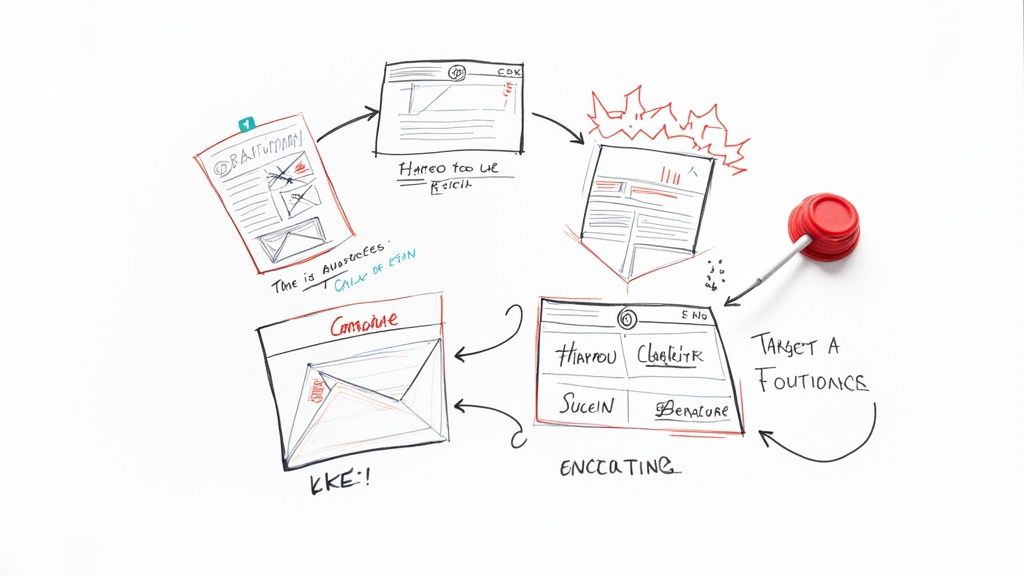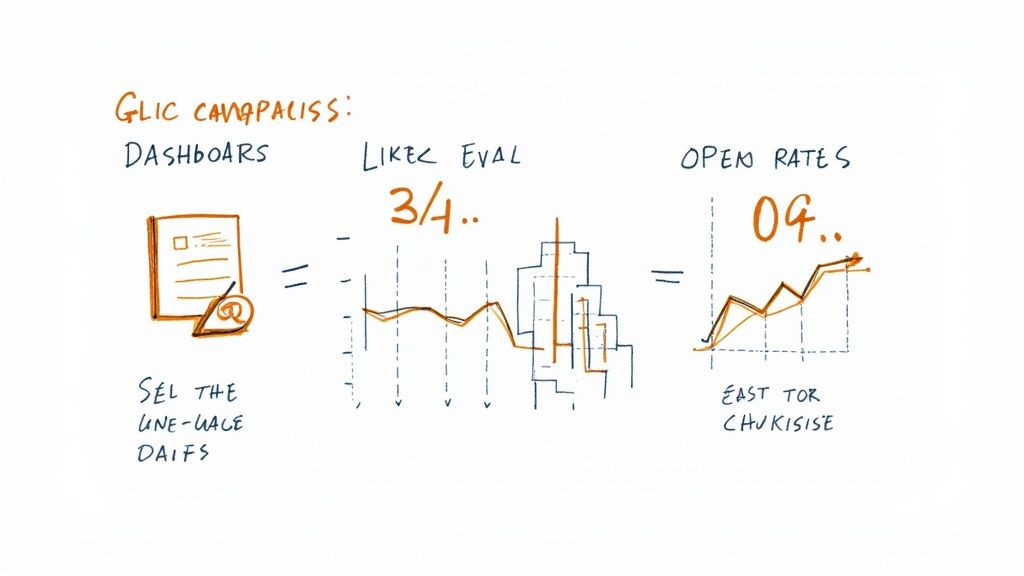Email Marketing Tips That Boost ROI by 122%
Understanding the True ROI Potential of Email Campaigns

When it comes to marketing channels, email consistently delivers exceptional returns, with studies showing a median ROI of 122%. While the often-quoted statistic of "$42 return for every$ 1 invested" catches attention, the real story goes much deeper. Success with email marketing isn't automatic - it requires understanding the key factors that drive performance and applying proven strategies effectively.
Deconstructing the $42 ROI Benchmark
That impressive $42:1 return represents an average across many campaigns and industries. The best performers often see much higher returns by going beyond basic email blasts. What sets top campaigns apart? It comes down to careful audience targeting, relevant messaging, and smart delivery timing. For example, an online retailer that segments customers based on past purchases and sends personalized product recommendations will likely see better results than one sending the same generic promotions to everyone.
The Power of Strategic Timing and Audience Insights
Great email campaigns start with really knowing your audience - their needs, challenges, and buying patterns. This knowledge helps you craft messages that truly connect. Timing is also critical. An email promoting a lunch special will perform better at 10 am than at 8 pm. Understanding these patterns helps you reach people when they're most likely to engage with your content.
Measuring True Campaign Value: Beyond Open Rates and Clicks
While tracking opens and clicks gives useful data points, they only tell part of the story. Real campaign value shows up in metrics like lead quality, customer retention, and sales growth over time. Look at how your emails guide customers through their buying journey - from first learning about your products to becoming loyal repeat buyers.
Real-World Examples: Email Marketing Campaign Tips in Action
Take a small beauty brand as an example. By creating separate email lists for different skin concerns and sending targeted content to each group, they turned a basic newsletter into a personalized shopping advisor. Or consider how tech companies use timed email sequences to welcome new users, show them key features, and keep them engaged with the product. These focused approaches build stronger customer relationships and drive better results.
Smart email marketing means thinking beyond basic metrics to create campaigns that truly connect with your audience. By combining solid data analysis with deep customer understanding, you can develop email strategies that consistently deliver strong returns. This foundation sets you up to implement specific tactics that will work for your unique business goals.
Mastering the Science of Email Timing and Frequency
The success of an email marketing campaign depends heavily on getting the timing and frequency just right. Like having a conversation, it's not just about what you say, but when you say it. Understanding when to send emails and how often helps you keep subscribers engaged while respecting their inbox space. It's similar to maintaining a relationship - you want to stay in touch regularly without becoming overwhelming.
Why Timing Matters in Email Marketing
Your email's arrival time directly affects whether subscribers will open and engage with it. Send at the wrong moment, and your carefully crafted message might get lost in a flood of other emails. For instance, promoting a weekend sale early Monday morning likely won't resonate with people focused on starting their workweek. Being strategic about when you schedule campaigns helps ensure your messages reach people when they're most likely to pay attention.
Finding Your Optimal Send Times
While general guidelines exist, the ideal send time varies based on your specific audience and industry. Most Mailchimp, Constant Contact and other email platforms provide data showing when your subscribers are most active. Study these analytics to understand your audience's natural engagement patterns. Running A/B tests with different send times lets you discover what works best for your unique subscriber base. Sometimes shifting your schedule by just an hour can significantly boost open rates.
The 9-16 Emails Per Month Sweet Spot
Research shows sending 9-16 emails monthly tends to drive the highest engagement, but content quality matters more than volume. Flooding inboxes with irrelevant messages leads to unsubscribes and hurts your sender reputation. Focus on making each email count by providing real value - whether that's exclusive content, practical tips, or meaningful offers. A thoughtful approach targeting subscriber interests works better than frequent but generic messages.
Adapting Your Strategy Based on Audience Behavior
Different subscriber segments have different preferences for email frequency. Watch key metrics like open rates, click-throughs, and unsubscribes to gauge if you're hitting the right balance. When unsubscribe rates jump after increasing frequency, that's a clear signal to dial things back. Regular monitoring and adjustments keep your email program aligned with what your audience wants.
Measuring Engagement Patterns and Identifying Optimal Sending Windows
| Metric | Description |
|---|---|
| Open Rate | Percentage of recipients who opened your email. |
| Click-Through Rate (CTR) | Percentage of recipients who clicked on a link within your email. |
| Unsubscribe Rate | Percentage of recipients who unsubscribed from your email list after receiving a specific email. |
| Conversion Rate | Percentage of recipients who completed a desired action (e.g., purchase, sign-up) after clicking a link. |
Tracking these metrics while testing different approaches helps optimize your email marketing over time. Success comes from consistently analyzing data, experimenting with timing and frequency, and focusing on subscriber value. This sustained effort builds lasting relationships with your audience and improves campaign results.
Creating Mobile-First Email Experiences That Convert

Most people now read emails on their phones, making mobile optimization essential for successful email marketing campaigns. A poorly optimized mobile email experience can hurt engagement and cost you valuable conversions. Let's explore how to create emails that look great and drive action on mobile devices.
Designing for Thumbs: The Importance of Mobile-Friendly Layouts
Consider how you naturally use your phone - scrolling and tapping with your thumb as you move through content. This simple behavior should guide your email design choices. Make buttons and links large enough to tap easily (at least 44x44 pixels). Avoid cramming elements too close together, as this leads to accidental clicks and frustration. Use a minimum 14-pixel font size to ensure text remains readable without zooming. The goal is to create an experience that feels natural and effortless on a small screen.
Responsive Design: Adapting to Every Screen
Good responsive design means your emails look perfect whether opened on a phone, tablet, or desktop. This requires using flexible layouts and images that automatically resize based on screen dimensions. Have you ever tried reading a desktop-formatted email on your phone? The tiny text and horizontal scrolling make it nearly impossible. That's why responsive design is crucial - it ensures your message comes through clearly on any device.
Prioritizing Content Hierarchy for Mobile Readers
Mobile users often check email while multitasking or on the go. Structure your content to deliver key information immediately, using clear headings and short paragraphs. Break up text with bullet points and white space to improve scannability. Place your most important message and call-to-action near the top. This way, even readers who skim quickly will grasp your main points and desired action.
Testing and Optimizing for a Seamless Mobile Experience
Creating effective mobile emails requires thorough testing across different devices and email clients. Use your email platform's preview tools to check how your design renders on various screen sizes. Run A/B tests comparing different layouts, content structures, and calls-to-action to see what resonates with your audience. Just like you'd test a new product before launch, testing your emails helps refine the experience for optimal results.
The Impact of Mobile Optimization on Email Marketing ROI
When you optimize for mobile, you remove friction from the reading and response process. This leads to better engagement metrics - higher open rates, more clicks, and increased conversions. Mobile-friendly emails show respect for your readers' time and attention, helping build lasting relationships that benefit your bottom line. Focus on creating seamless mobile experiences, and you'll see the impact in your campaign results.
Implementing Advanced Segmentation Strategies
We've covered essential email marketing basics like timing and mobile optimization. Now let's explore how advanced segmentation can take your campaigns to the next level. Rather than just sorting customers into broad demographic groups, this approach creates truly personalized communication. The numbers back this up - 51% of marketers say segmentation is their most effective email strategy.
Why Go Beyond Basic Segmentation?
While basic demographic segments like age and location provide a starting point, they often miss the nuances that make customers unique. It's like the difference between sending a generic flyer to every house on the block versus writing personal notes to neighbors based on your shared interests and conversations. When you target specific groups with relevant messages at the right moment, both engagement and conversions naturally improve.
Utilizing Behavioral Data for Hyper-Personalization
The key to advanced segmentation is understanding how customers actually interact with your business through their actions. This includes what they buy, which pages they visit, which emails they open, and how they engage on social media. For instance, if someone frequently checks out running gear on your site, you can add them to a running enthusiast segment and send them updates about new shoes or local races. This focused approach consistently leads to higher click rates.
Combining Behavioral and Traditional Data
The best results come from blending behavior patterns with basic customer information. For example, an outdoor retailer promoting hiking boots could identify customers who: 1) Live near popular trails and 2) Previously purchased hiking equipment. This targeted outreach works far better than sending the same message to everyone.
Practical Examples of Advanced Segmentation in Action
Here's how different organizations put this into practice:
- E-commerce: Creating segments based on purchase frequency helps deliver personalized product suggestions and rewards
- SaaS Companies: Identifying inactive users enables specific win-back campaigns
- Nonprofits: Segmenting donors by giving patterns allows for more relevant fundraising requests
These real-world applications show how segmentation helps deliver the right message to the right audience.
Measuring and Scaling Your Segmentation Efforts
Success requires tracking key metrics for each segment, including:
| Metric | Description |
|---|---|
| Open Rate | Percentage of recipients who opened the email. |
| Click-Through Rate | Percentage of recipients who clicked a link in the email. |
| Conversion Rate | Percentage of recipients who completed a desired action (e.g., a purchase). |
| Revenue per Segment | Total revenue generated from a specific customer segment. |
This data shows what's working and what needs adjustment. For example, if certain segments consistently underperform, you might need to refine their criteria or test different messaging. Regular analysis helps you build a scalable approach that delivers measurable results while staying focused on your business goals.
How Automation Powers Revenue Growth

While smart customer segmentation helps target the right audiences, adding automation takes your email marketing to the next level by delivering perfectly timed messages. The numbers speak for themselves - automated campaigns bring in 320% more revenue than traditional email campaigns. But this isn't about removing human connection - it's about using smart tools to make those connections even stronger. Let's explore exactly how automation can drive these impressive results.
Key Automated Workflows That Get Results
Several automated sequences consistently deliver strong returns. Take welcome emails, for example. When a new customer signs up for your online store, they immediately receive a warm thank you message with a special discount code. A few days later, they get product recommendations based on their interests or helpful tips related to their first purchase. This natural progression builds trust from day one. Similarly, cart abandonment reminders gently prompt customers about items they left behind, often offering assistance or incentives that help recover sales that might otherwise be lost.
Combining Triggers and Personal Touches
The real impact comes from pairing behavior-based triggers with personalized content. Here's how it works: When someone browses winter coats on your website, it automatically triggers an email showing similar styles, seasonal deals, or cold-weather fashion tips. This focused approach feels like having a personal shopping assistant who understands exactly what you're looking for. The result? Higher engagement and more sales since every message is relevant to the customer's interests.
Building and Refining Your Automated Systems
Creating effective automated emails requires careful planning. Start by setting clear goals for each sequence - whether it's welcoming new subscribers, recovering abandoned carts, or following up after purchases. Map out how customers typically interact with your business and identify key moments to send messages. Write compelling emails that move customers toward your goals while staying true to your brand voice. Then test everything - from subject lines to button colors - to find what works best for your audience.
Real Examples and Results Across Industries
Different businesses use automation in creative ways to drive results. A clothing store sends style suggestions based on past purchases and browsing history. Software companies guide new users through key features with well-timed onboarding emails. Travel agencies send destination deals to people who've been researching specific locations. Across the board, these targeted approaches work - welcome emails with personalization and automation generate 320% more revenue than basic welcome messages. The key is to track your results and keep improving your sequences over time. This creates a cycle of better engagement, stronger relationships, and growing revenue. By putting these email strategies into practice, you're not just boosting sales - you're building lasting connections with customers who keep coming back.
Mastering Testing and Optimization Techniques

Once you've set up automation and segmentation, it's time to focus on testing and optimization - the key ingredients that will take your email marketing to the next level. Instead of just hitting send and hoping for success, you need a systematic approach to measure what works and refine your strategy over time. The data you collect from testing helps you make smarter decisions that boost engagement and drive better results.
Why Testing Is Crucial for Email Marketing Campaign Tips
Think of testing like fine-tuning a recipe - you try different combinations until you find what your audience loves most. By running controlled experiments with your email campaigns, you can discover exactly which elements get people to open, click, and convert. For example, testing two different subject lines might reveal that short, benefit-focused headlines get 30% more opens than longer, descriptive ones. Testing also helps you avoid costly mistakes by validating your ideas with real data before rolling them out to your entire list.
Key Elements to Test in Your Email Campaigns
There are several essential components worth testing in your emails. Subject lines make the crucial first impression - even small changes in wording or length can dramatically affect open rates. Test whether adding emojis helps or hurts, and if questions work better than statements. Inside the email itself, try different layouts, writing styles, and button designs. Does a focused three-paragraph message outperform a detailed long-form email? The only way to know is to test. You'll also want to experiment with send timing to catch people when they're most likely to engage, especially when combined with segmented content for different subscriber groups.
Building a Robust Testing Framework
A structured approach prevents random, ineffective tests and generates actionable insights. Start by setting clear goals - do you want to boost opens, clicks, or sales? Then pick one element to test, like subject lines, and create distinct variations. Use a representative sample of subscribers that mirrors your overall audience demographics. After the test runs, analyze the results carefully and apply what you learned to future campaigns. This methodical process leads to steady improvements in your email performance.
Beyond A/B Testing: Exploring Multivariate Testing
While A/B tests compare two versions of one element, multivariate testing examines how multiple components work together. You might test different combinations of headlines, images, and call-to-action buttons in the same campaign. This reveals valuable insights about element interactions, though it requires larger subscriber samples and more advanced analytics tools. Careful planning is essential to get clear, meaningful results from multivariate tests.
Practical Tools and Metrics for Optimization
Many email platforms provide built-in testing capabilities to track key metrics like open rates, click rates, and conversions. Regular analysis of this data reveals patterns you can use to improve your campaigns over time. Remember that effective email marketing requires ongoing optimization - use testing insights to continuously refine your approach based on what resonates with your audience.
Want to streamline your customer interactions and boost conversions with a powerful AI chatbot? Check out Sitebot at https://sitebot.co and transform your customer engagement strategy today.


